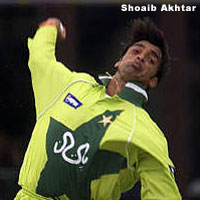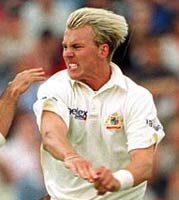Speed freaks
Daniel Laidlaw
The thought of the world's two fastest bowlers competing against each other
for a world record should conjure up all sorts of hostile images. One
imagines them pawing the ground, snarling and glaring, attempting to
intimidate and decapitate. They should be dishing out bouncers, bruises and
belligerence. Projecting a hostile attitude in what is often a hostile
sport; wickets and warfare. At best, one envisions a healthy dislike, and if
that rivalry took place on the field, that's probably the way it would be.
Yet the rivalry between cricket's two fastest men, Shoaib Akhtar and Brett
Lee, is really no rivalry at all. Incongruously, Akhtar and Lee are friends,
reminding us that fast bowlers are not necessarily a menace to anyone and
everyone. They like each other.
Lee, who last season bowled bouncers in an attempt to hit tail-ender Makhaya
Ntini, was thrilled that Shoaib won the race to break the magical 100mph
barrier. "It's great that a person has finally clocked that 160 and I'm just
really excited for him and really proud of him. It's a bit like that
four-minute mile thing and for a person to actually finally achieve it is
fantastic," Lee gushed.
 Shoaib has previously expressed similar sentiments about his Aussie mate Lee. Next thing you know, they'll be observing the old fast bowler's code and refusing to bowl bouncers at each other - or maybe
not.
Shoaib has previously expressed similar sentiments about his Aussie mate Lee. Next thing you know, they'll be observing the old fast bowler's code and refusing to bowl bouncers at each other - or maybe
not.
Throughout their relatively short careers thus far, the two fast men with an
admirable respect for one another have been setting new standards for each
other. Akhtar was the fastest man in the world before Lee arrived, with the
stated ambition of doing what no-one else was recorded to have done and bowl
100mph. Bowling fast was a gift from God, Shoaib said, and he intended to
use it, even at the expense of a long career.
Shoaib and Lee first went head-to-head in the one-day series in Australia in
early 2000, with Lee going on to set a new fastest mark in South Africa,
only for Shoaib to top it and force Lee to go one better again. Both have
had their share of setbacks in the battle for pace supremacy, Shoaib
particularly so. Twice reported for a suspect action due to a hyper-extended
elbow that reportedly gives the illusion of throwing, Shoaib has also
battled a series of injury problems, as express bowlers inevitably do. Lee's
action was also once reported and he underwent elbow surgery in early 2001,
from which he has only recently regained full form and velocity.
When Lee bowled a delivery at 157.4kmh in South Africa in March, he appeared
closer than ever to becoming the first to top 160.9kmh, the equivalent of
100mph. But a fit Shoaib responded, recording a delivery at 159.5kmh in
Sharjah before breaking the barrier with a ball reportedly timed at 161kmh
on a sponsor's speed gun during the third ODI against New Zealand in Lahore.
Mission accomplished.
Some would downplay the importance of striving for pace, however. This
happened when Akhtar first toured Australia in 1999/'00. "Sure," went tone
of Australian reports, "he can bowl fast, but it doesn't mean anything if he
can't take wickets." Funny how that changed when Brett Lee burst onto the
scene later that season, when the excited talk became all about how Lee
could break Jeff Thomson's record.
While wickets will always remain the fundamental barometer of a bowler's
performance, pace is an enviable asset, and it is possibly envy that
motivates people to dismiss its relevance. Those who possess it have the
invaluable ability to make something happen when previously life was
comfortable for batsmen. It is a natural advantage and one all captains
would surely love to call upon. That is borne out by Australia carrying Lee
last year through mediocre form following his injury. He could still bowl
some quick spells, and they wanted him there when he did.
Still, some would denigrate it, and to them we say look at history. The
truly great were also usually the truly fast: West Indians like Marshall,
Holding and Roberts, Australians Lillee and Thomson, Englishmen Fred Trueman
and Frank 'Typhoon' Tyson all the way back to Fred 'Demon' Spofforth. The
economical trundlers, while also having their place, are not inspiring
match-winners and do not have the same potential to achieve great feats. At
speed, there is always the possibility of the spectacular.
Witness Glenn McGrath, an outstanding seam bowler and champion by any
definition. His control and precision and is immaculate. At the same time,
you would not want every bowler to be identical to McGrath. While heartily
appreciated, he does not generate the same type of excitement as an Akhtar
or Lee, because he lacks one thrilling characteristic - pace. An ability to
propel the ball at frightening speed, dangerous to both the batsman and,
unfortunately, all too often the bowler testing the limits of his body by
doing the unnatural.
Accuracy, control, line and length - all these things can be developed with
time, teaching and experience. Raw speed cannot, which it is why it is a
prized and much sought-after asset. How much interest would there be in an
accuracy measuring device? McGrath has that competition won, but his craft
is not quite as compelling.
 It must be noted bowling fast is not all Akhtar does quickly, though. He was
also second-fastest to 100 ODI wickets, behind team-mate Waqar Younis, at
the exceptional average of 19.63. That punches a hole in the theory that all
he does is bowl quick, though it's certainly true he has under-achieved as a
Test bowler, where endurance and building pressure is more of a factor. 63
wickets at 32.52 from 20 Tests is one a fit, and now focussed Shoaib should
improve on. He finally has his priorities in order. "I am no longer just
concentrating on speed," Shoaib said recently. "I am also thinking about
line and length and sticking to a more consistent line. You can't be a
quality bowler without that." Unsurprisingly, he broke the record after that
statement, emphasising the importance of rhythm, which Lee has also spoken
about.
It must be noted bowling fast is not all Akhtar does quickly, though. He was
also second-fastest to 100 ODI wickets, behind team-mate Waqar Younis, at
the exceptional average of 19.63. That punches a hole in the theory that all
he does is bowl quick, though it's certainly true he has under-achieved as a
Test bowler, where endurance and building pressure is more of a factor. 63
wickets at 32.52 from 20 Tests is one a fit, and now focussed Shoaib should
improve on. He finally has his priorities in order. "I am no longer just
concentrating on speed," Shoaib said recently. "I am also thinking about
line and length and sticking to a more consistent line. You can't be a
quality bowler without that." Unsurprisingly, he broke the record after that
statement, emphasising the importance of rhythm, which Lee has also spoken
about.
Despite his relatively poor form since returning from injury, Lee's start to
his Test career was such that his overall record is still a highly
respectable 84 wickets at 26.82. The indications from his series against
South Africa were that his previously impressive control might be returning,
too. This strongly suggests that these guys are much more than just speed
freaks who spray the ball all over the pitch without heed of wicket-taking
or economy, in which case they would not attract the attention they do.
Conformity in measuring devices is needed for the records to have
credibility or to be meaningfully compared, though that should not detract
too much from Shoaib's record being achieved using the device present, since
bowling at 100mph was always about prestige rather than being a landmark in
real terms. Adam Gilchrist, who kept to Lee at his then-record speeds in the
second Test in March, thought the record deliveries were not particularly
quick. "I didn't think it was all that quick, I've got to be honest,"
Gilchrist was quoted as saying at the time. "Sometimes you take the ball and
you think, 'gee, that was really quick' and you look around and it's 145.
And other times you look up and there's a high figure up there and you don't
think it was that quick. So with all due respect to the sponsors of the
speed gun, I'm not 100 per cent sure how accurate it is."
It's hard to find a better placed judge than the wicketkeeper. It's also a
concern that the speed guns used are sponsored by the TV stations or their
advertisers, as the networks would seem to have an obvious interest in
records being broken with their devices to attract ratings. But it matters
not, as Shoaib and Lee are established as the two fastest regardless.
There have been many great fast bowlers and there will be others. The
announcement of the likely retirement of one of the all-time greats, Wasim
Akram, after the 2003 World Cup, underlines the perpetual sporting cycle of
young and old. At the moment, we have Akhtar and Lee, and they deserve to be
celebrated. After all, they're already toasting each other.
More Columns
Mail Daniel Laidlaw